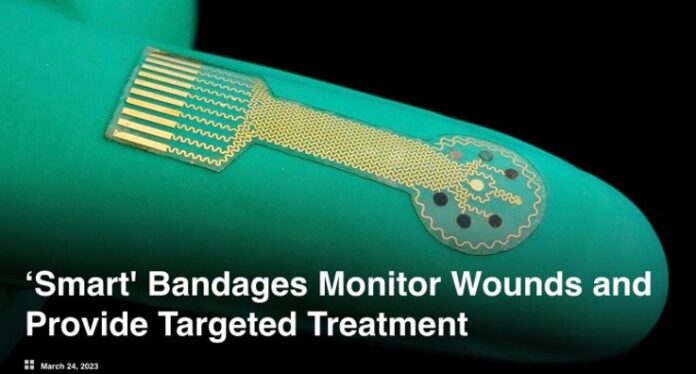Please welcome back Tarina Hawkins. This is her second contribution to 21st Century Tech Blog. Tarina loves doing research and writing on a variety of topics. She prides herself in taking complex subjects and making them easy to understand. When not writing, she enjoys being outdoors in summer weather. Her topic today is bandages and how what we used to put on to cover an “ouchy” is becoming far more sophisticated.
Smart bandages with ultra-tiny biosensors that monitor wounds to help heal them faster are being developed by researchers at the California Institute of Technology (Caltech). They will soon be joining smart antibiotics in modernizing our arsenal of tools to help fight diseases and heal.
The bandages are made using a flexible polymer that contains an electronic circuit board, as well as a reusable patch with embedded biosensors, electrodes, and medications. The bandage can monitor a wound site and send information to wireless devices, release personalized medication, or emit low-level electrical fields to aid in healing. Smart bandages have the potential to treat chronic wounds like diabetic ulcers that are slow to heal and at high risk of infection.
Smart Bandage Biosensors Monitor Wound Health
Smart bandages feature biosensors that provide insight into how well a wound is healing. The biosensors monitor temperature, pH, and levels of lactate, ammonium, glucose, and uric acid. These metrics can indicate signs of inflammation and infection, as well as the stage of wound healing.
“Biochemical signals open up new opportunities because you’re able to really probe what’s happening on a molecular level,” comments biomedical researcher and engineer Yuanwen Jiang, now at the University of Pennsylvania. “That’s the key novelty here.” The bandage then transmits this data to a wireless device like a smartphone, tablet, or computer for the patient or the doctor to see.
Drug-infused Hydrogels Help Healing
Smart bandages can treat a wound site with drug-infused hydrogels. When stimulated by an electrode, these anti-inflammatory and antimicrobial hydrogels get released into the wound site. A second electrode can also apply a low-level electrical field to the site. Electrical stimulation has previously been proven to assist in wound closures as it encourages tissue growth, prevents inflammation, oxygenates, and promotes overall faster healing. “All the signals can be wirelessly sent to a user interface [such as] a computer or a cellphone,” explains Dr. Wei Goa, an assistant professor of medical engineering at Caltech. “We can wirelessly control the drug release by applying electrical potential.”
Smart Bandages for Treating Chronic Wounds
Approximately 6.5 million people in the United States have to deal with chronic wounds. these are wounds that either won’t heal, heal slowly, or heal and recur. Take diabetes as an example. Around 15 to 20% of diabetics are likely to sustain a chronic wound as high blood sugars narrow the blood vessels hampering, circulation and preventing healing blood cells from reaching wound sites. It isn’t easy to find chronic wound data. A Canadian source estimates the prevalence of diabetic foot ulcers in 75 people per 100,000 representing 60% of diabetics in the country. Extrapolating that number to the U.S. with its estimated 34 million diabetics, it translates to more than 20 million who suffer from foot ulcers that are slow healing.
Diabetics generally are at higher risk for health problems and medical emergencies with visits to hospital emergency rooms (ERs) having risen over 25% in the last decade. Controlling blood sugar levels is key to reducing diabetic risks. Medical ID tags can help identify diabetics when communicating vital health information to medics becomes difficult such as in cases where the wearer is unable to speak. Visit rates by adults with diabetes to ERs in 2020 and 2021 in the U.S. represented 72.2 per 1,000. That rate continues to rise as the population ages.
Smart Bandage Animal Studies Show Promise
In animal studies, the smart bandages are being used for one to two weeks before changing with an estimated cost per bandage of U.S. $12. The Caltech team has treated mice and rats with diabetes and found that the bandages successfully monitor temperature, pH, and glucose levels at the wound site, and also aid in the healing process. Mice with smart bandages have healed faster and experienced less scarring than mice with unbandaged wounds.
Human studies should begin this year. The Caltech researchers also expect the results from these studies to be positive. Smart bandages may even be rolled out in clinics and hospitals within the next five to ten years, according to Dr. Gao.









